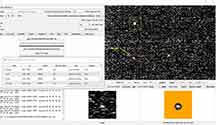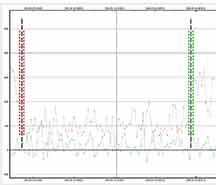

This is a IOTA event, by a large asteroid whose shadow will include all Karl, me, and Kirk from home. Unfortunately, all of our tracks lie almost on top of each other, so it would add value to move northwest or southeast. I may try from Cabrillo Observatory. However, the RUWE is 1.9, larger than the limit for high accuracy star position which is 1.2. Very nearby contaminating star? "wide" binary (not spectroscopic binary?)?
Alt=69, Az=128 in Pegasus. The duration is a long 3.7s
 |
 |
My data shows a strong high confidence event one asteroid radius early vs the nominal prediction time (OW always rounds to the nearest second, so more precision is not possible to give than approximate to within a half second or so). However, the depth is much less than predicted. Presumably there is another star inside the radius, but my 4 px circular radius should not be cut further or else missing star light will happen. Kirk Bender finds a very similar partial depth, yet we were not in the same location, and so perhaps the 2nd star is not part of a very close spectroscopic binary but instead is farther away. The shape of the image on the video does not look obviously binary vs the shape of the reference stars.
My first reduction used ref2, which is similar to the target and fainter than ref1. But I got a persistent waviness in the target light curve that I could not get rid of. Using the brighter ref1, this was much flatter, as is the original un-calibrated raw light curve. Something poorer about ref2 for a reference so I did not use it in my final and reported analysis results.
Evidence of 2nd star contamination...Kirk and I both get about a 60-70% drop in light, not the 4-5 magnitudes listed in the OW predictions in V or R. My (our) light drop has to be calculated including the up-biased sky level due to IRE=0 in my PAL camera. Kirk's is set to IRE=7.5 and should have a zero avg for the sky (but in fact it looks a bit up-biased as well, perhaps from faint stars not seen in his sky aperture?) Karl von Ahnen's data has not yet been analyzed. But this partial drop is very significant in interpretting the astrometry implied by the results, and this should be highlighted in each observers' reports to IOTA. If the contaminating star were part of a very close spectroscopic binary, you'd expect our light curves would show a step. Instead, we see no step in light curves, suggesting the target is a blend of two stars which only one was occulted by the asteroid, for both of us. But the target does not look to have a significant contaminating star on C2A, and the shape of the star is not conclusive in this. A close look at the SDSS sky photos is below. No obvious argument for contaminating star here...
But - the RUWE is 1.9, so something about the star position is not ideal from the star position data. Perhaps indeed a very close dimmer companion not far enough from the target to show on the SDSS image.
|
nearest possible contaminating star labelled. The sharp diffraction spikes on the target star indicate is it not a blend of two similar stars unless they are essentially on top of each other. |
Watec 910hx image, with estimated position of the possible contaminating star. But the size of the aperture 4px would not include this star, and it is also quite faint relative to the primary and not the brightness needed to reduce the mag drop so much as observed (unless very very red, and the SDSS image is in G?) |
PyOTE finds a strong positive event in my data...
magDrop report: percentDrop: 61.9 magDrop: 1.048 +/- 0.094 (0.95 ci) (not valid, since sky level is assumed in PyOTE to be zero and it is not, but at level=42. Actual light loss = 70% relative to measured sky level)
DNR: 2.51
D time: [04:25:29.4355]
D: 0.6800 containment intervals: {+/- 0.0151} seconds
D: 0.9500 containment intervals: {+/- 0.0451} seconds
D: 0.9973 containment intervals: {+/- 0.1156} seconds
R time: [04:25:32.7608]
R: 0.6800 containment intervals: {+/- 0.0151} seconds
R: 0.9500 containment intervals: {+/- 0.0451} seconds
R: 0.9973 containment intervals: {+/- 0.1156} seconds
Duration (R - D): 3.3253 seconds
Duration: 0.6800 containment intervals: {+/- 0.0240} seconds
Duration: 0.9500 containment intervals: {+/- 0.0611} seconds
Duration: 0.9973 containment intervals: {+/- 0.1313} seconds
 |
 |
 |
 |
 |
 |
 |
Clear 3.7 sec positive for Bitias, 2x at the Berm.
magDrop report: percentDrop: 56.6 magDrop: 0.906 +/- 0.087 (0.95 ci) (RN: But is the sky level truely zero? It looks to be about level=25 during the event, which would then mean a light loss not of 56.6% but of 61%)
DNR: 2.62
D time: [04:25:29.4788]
D: 0.6800 containment intervals: {+/- 0.0146} seconds
D: 0.9500 containment intervals: {+/- 0.0423} seconds
D: 0.9973 containment intervals: {+/- 0.1120} seconds
R time: [04:25:33.1491]
R: 0.6800 containment intervals: {+/- 0.0146} seconds
R: 0.9500 containment intervals: {+/- 0.0423} seconds
R: 0.9973 containment intervals: {+/- 0.1120} seconds
Duration (R - D): 3.6703 seconds
Duration: 0.6800 containment intervals: {+/- 0.0234} seconds
Duration: 0.9500 containment intervals: {+/- 0.0620} seconds
Duration: 0.9973 containment intervals: {+/- 0.1357} seconds
 |
 |
 |
 |
Verdict: I think we've done all we can with this data. Strong positive occultations, but a possible contaminating star very close to the primary is suspected, to account for the shallower drops but yet no indication of steps (ie the nearby suspected star did not get occulted for either Kirk or I).